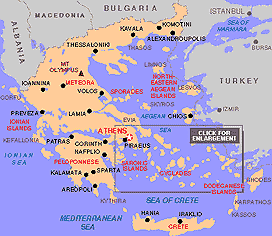| |

In the ancient world, wine from Greece was considered very fine and was widely exported. During the many centuries of Ottoman domination winemaking dwindled into a localized agricultural product. The long-drawn-out battle for freedom from the Turk left a modern emerging nation exhausted and with major economic problems, only to be faced by two world wars and a bitter civil war. With such a history it is small wonder that today's Greek wine industry should be thought of as a new enterprise which began in the 1960s.
In fact, a number of the large companies were founded in the 19th century, but their main concerns were brandy and ouzo, with wine very much an afterthought. Such wine would be sold directly from the barrel, and only during the 1960s did the idea of bottling before sale slowly spread. Moreover, the taste of these wines was dictated by the Greek palate of the day, which on the whole was for wines high in alcohol, low in acidity and frequently oxidized from being left too long in wood.
During the 1960s to 1980s the picture was altering. The Wine Institute in Athens had been created in 1937 to help and advise winemakers, and from 1952 it began to formulate a quality wine system which became law in 1969. The most spectacular advances came during the 1980s, with the arrival of temperature -controlled technology combined with a new wave of young, enthusiastic oenologists, many of whom had trained in France, Italy or Germany. At the same time the national palate was also changing, with a growing demand for fresher, clean and fruitier styles.
Today the Greek wine trade has a new element. The major firms, who may own vineyards, buy most of their grapes from small farmers and often produce wine in a number of different areas throughout Greece. Local cooperatives produce wine from their members' grapes. They may sell under their own label, or sell on to other producers, or both. Now there is a third type of company: the small, often family-run enterprises that grow their own grapes, and occasionally buy those of growers with whom they work very closely. Production here is relatively small and is mostly sold on the home market, where there is a big demand, but some is available for export.
By and large the export market is dominated by the following major firms: Achaia-Clauss, J Boutari & Son, D A Kourtakis, Tsantalis. Other names that can be found include Domaine Carras from northern Greece, Semeli from central Greece, and the Muscat wines from the coops of Samos and Lemnos.
|
|
|
|


